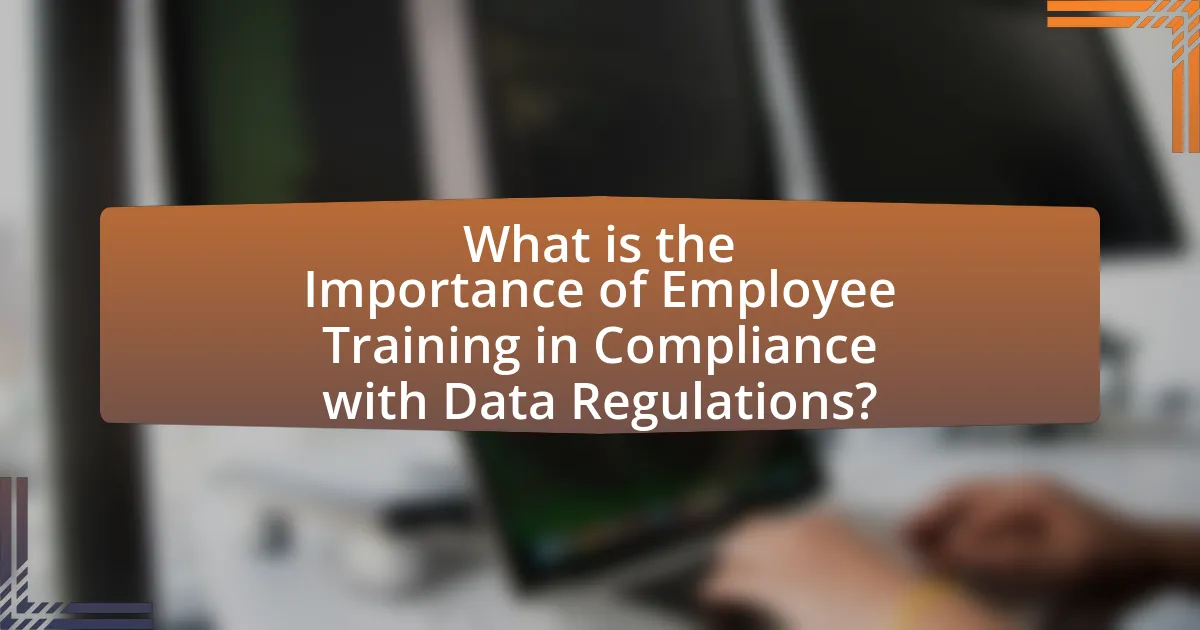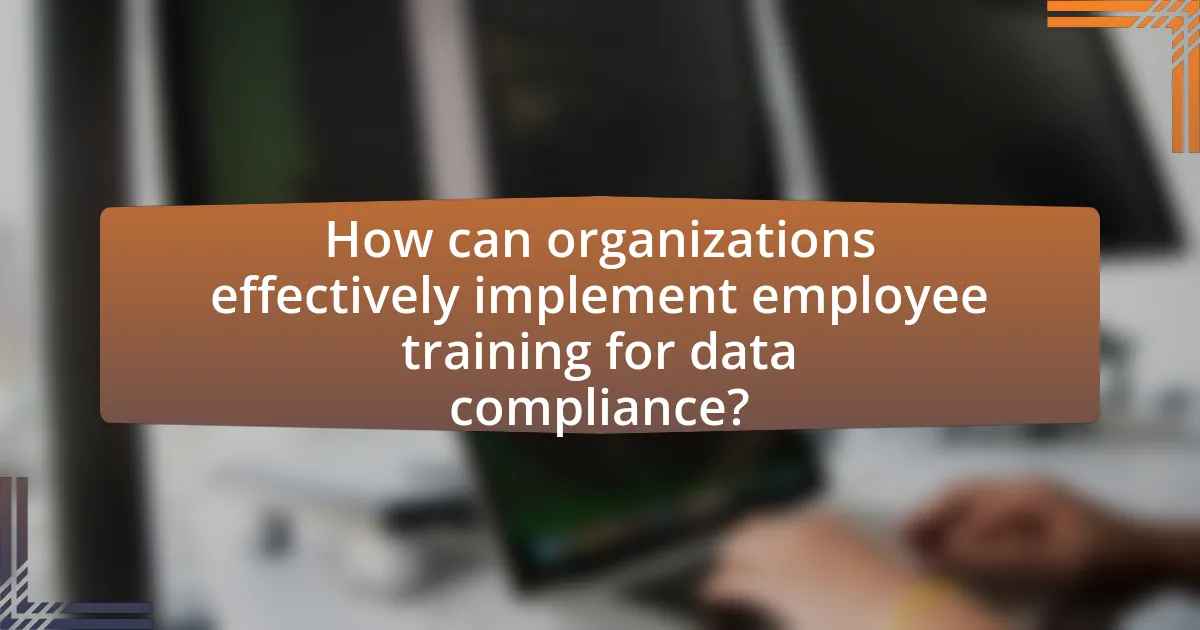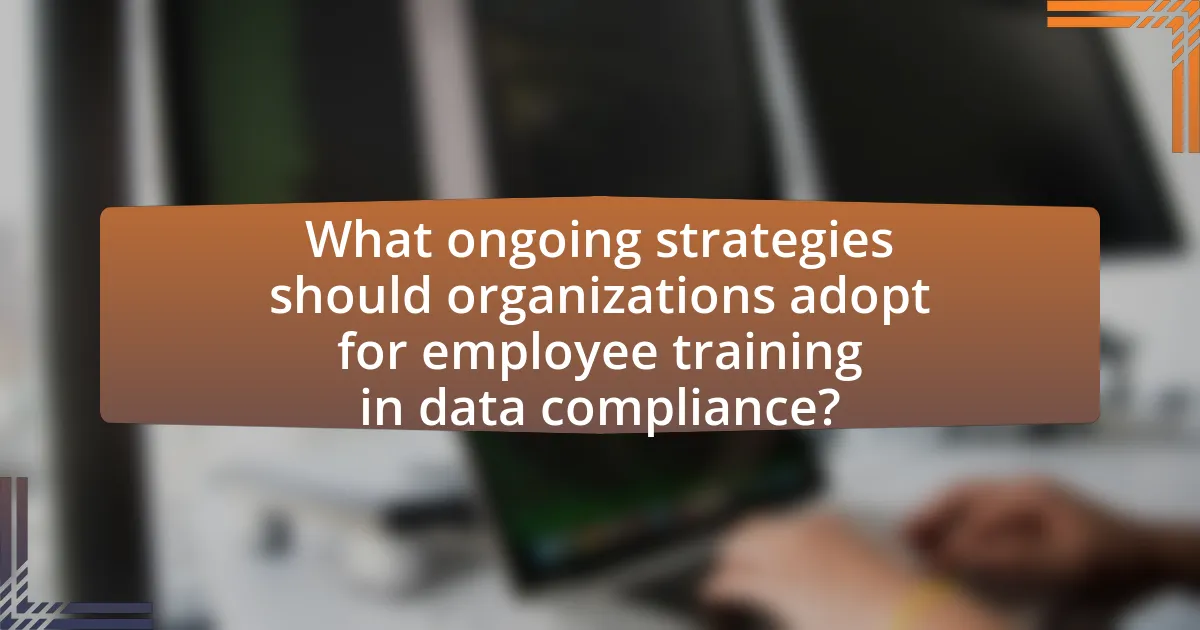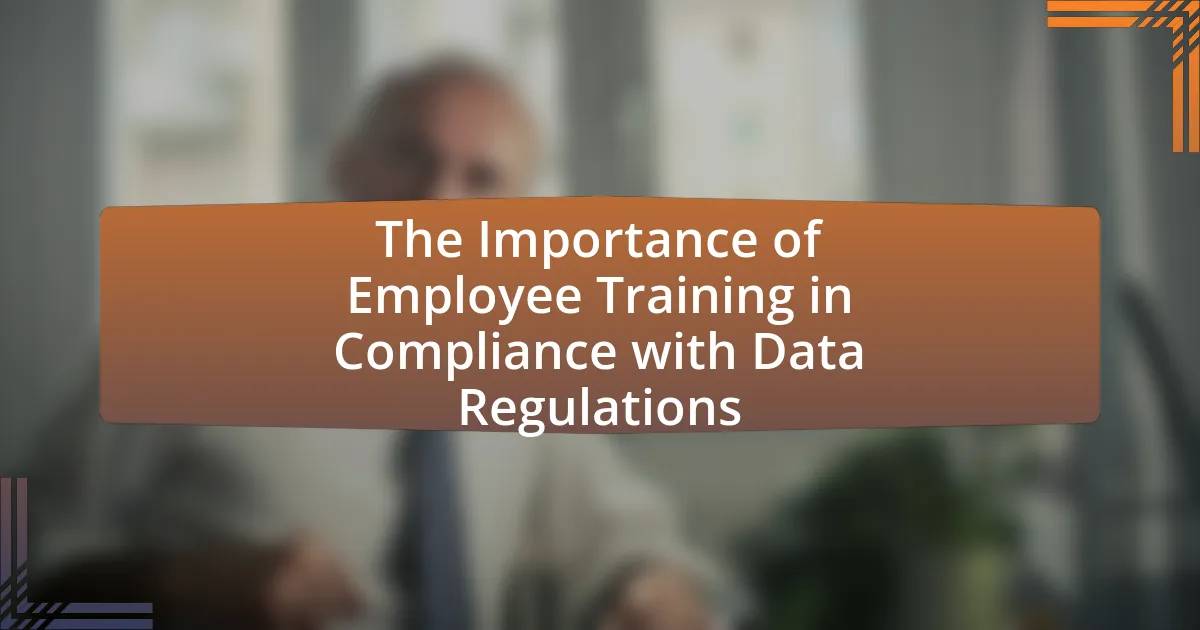Employee training is essential for compliance with data regulations, as it provides staff with the necessary knowledge and skills to manage sensitive information responsibly. The article highlights the significance of training programs in understanding legal requirements such as GDPR, HIPAA, and CCPA, emphasizing that organizations with comprehensive training experience significantly fewer data breaches. It discusses the consequences of inadequate training, including legal penalties and reputational damage, and outlines best practices for developing effective training programs. Additionally, the article explores the role of technology and data analytics in enhancing training outcomes, as well as the importance of continuous education to adapt to evolving regulations.

What is the Importance of Employee Training in Compliance with Data Regulations?
Employee training is crucial for compliance with data regulations as it equips staff with the knowledge and skills necessary to handle sensitive information responsibly. Proper training ensures that employees understand the legal requirements, such as GDPR or HIPAA, and the potential consequences of non-compliance, which can include hefty fines and reputational damage. For instance, a study by the Ponemon Institute found that organizations with comprehensive training programs experienced 50% fewer data breaches compared to those without. This highlights the direct correlation between effective employee training and enhanced data security, reinforcing the importance of ongoing education in maintaining compliance with evolving data regulations.
Why is employee training crucial for data regulation compliance?
Employee training is crucial for data regulation compliance because it equips staff with the necessary knowledge and skills to understand and adhere to legal requirements. Proper training ensures that employees are aware of data protection laws, such as the General Data Protection Regulation (GDPR), which mandates that organizations implement appropriate measures to safeguard personal data. According to a study by the Ponemon Institute, organizations that provide comprehensive data protection training experience 50% fewer data breaches compared to those that do not. This highlights the direct correlation between effective employee training and enhanced compliance with data regulations.
What are the key data regulations that organizations must comply with?
Organizations must comply with key data regulations such as the General Data Protection Regulation (GDPR), the Health Insurance Portability and Accountability Act (HIPAA), and the California Consumer Privacy Act (CCPA). GDPR, enacted in 2018, mandates strict data protection and privacy for individuals within the European Union, imposing heavy fines for non-compliance. HIPAA, established in 1996, sets standards for the protection of health information in the United States, ensuring confidentiality and security of patient data. CCPA, effective from 2020, grants California residents rights regarding their personal information, including the right to know what data is collected and the right to request deletion. Compliance with these regulations is crucial for organizations to avoid legal penalties and maintain consumer trust.
How does employee training mitigate risks associated with data breaches?
Employee training mitigates risks associated with data breaches by equipping staff with the knowledge and skills necessary to recognize and respond to security threats. When employees understand the importance of data protection and the specific tactics used by cybercriminals, they are less likely to fall victim to phishing attacks or mishandle sensitive information. According to a report by the Ponemon Institute, organizations that provide comprehensive security awareness training can reduce the likelihood of a data breach by up to 70%. This training fosters a culture of security, ensuring that employees are vigilant and proactive in safeguarding data, thereby significantly lowering the risk of breaches.
What are the consequences of inadequate employee training in data compliance?
Inadequate employee training in data compliance leads to significant risks, including data breaches, legal penalties, and reputational damage. Organizations lacking proper training may fail to adhere to regulations such as GDPR or HIPAA, resulting in fines that can reach millions of dollars. For instance, the average cost of a data breach in 2021 was $4.24 million, according to IBM’s Cost of a Data Breach Report. Additionally, employees untrained in compliance may inadvertently expose sensitive information, increasing the likelihood of cyberattacks. This lack of awareness can also lead to non-compliance audits, which can further strain resources and damage stakeholder trust.
How can non-compliance impact an organization financially and legally?
Non-compliance can significantly impact an organization both financially and legally by resulting in substantial fines, legal fees, and potential loss of business. Financially, organizations may face penalties that can reach millions of dollars; for instance, the General Data Protection Regulation (GDPR) allows fines up to 4% of annual global turnover or €20 million, whichever is higher. Legally, non-compliance can lead to lawsuits, regulatory investigations, and damage to reputation, which can further decrease customer trust and revenue. A study by the Ponemon Institute found that the average cost of non-compliance for organizations is approximately $14.82 million annually, highlighting the severe financial implications of failing to adhere to regulations.
What reputational risks do organizations face due to data breaches?
Organizations face significant reputational risks due to data breaches, including loss of customer trust, negative media coverage, and diminished brand value. When a data breach occurs, customers often feel their personal information is no longer secure, leading to a decline in loyalty and potential loss of business. According to a 2020 study by IBM, the average cost of a data breach is $3.86 million, which includes not only financial losses but also the long-term impact on reputation. Furthermore, negative media coverage can amplify public perception of an organization’s inability to protect sensitive information, resulting in lasting damage to its brand image. This erosion of trust can take years to rebuild, affecting customer retention and acquisition efforts.

How can organizations effectively implement employee training for data compliance?
Organizations can effectively implement employee training for data compliance by developing a structured training program that includes clear objectives, relevant content, and regular assessments. A well-defined training program ensures that employees understand data regulations, such as GDPR or HIPAA, and their implications for daily operations. Regular assessments, such as quizzes or practical scenarios, reinforce learning and gauge employee understanding, which is crucial for maintaining compliance. According to a study by the Ponemon Institute, organizations that invest in comprehensive training programs experience 50% fewer data breaches, highlighting the effectiveness of structured training in enhancing data compliance.
What are the best practices for developing a training program?
The best practices for developing a training program include conducting a needs assessment, defining clear objectives, creating engaging content, implementing diverse training methods, and evaluating effectiveness. Conducting a needs assessment ensures that the training addresses specific gaps in knowledge or skills, which is crucial for compliance with data regulations. Defining clear objectives provides a roadmap for what the training aims to achieve, aligning with organizational goals. Creating engaging content, such as interactive modules or real-life scenarios, enhances retention and application of knowledge. Implementing diverse training methods, including e-learning, workshops, and on-the-job training, caters to different learning styles and increases participation. Finally, evaluating effectiveness through assessments and feedback helps to measure the impact of the training and identify areas for improvement, ensuring ongoing compliance with data regulations.
How should organizations assess their training needs for data compliance?
Organizations should assess their training needs for data compliance by conducting a comprehensive gap analysis to identify existing knowledge deficits among employees regarding data regulations. This analysis involves evaluating current compliance policies, employee roles, and the specific data handling practices relevant to the organization. For instance, a study by the International Association of Privacy Professionals (IAPP) indicates that organizations with tailored training programs experience a 30% reduction in compliance violations. By aligning training initiatives with regulatory requirements and employee responsibilities, organizations can ensure that their workforce is adequately prepared to meet compliance standards.
What training methods are most effective for ensuring compliance?
Interactive training methods, such as simulations and role-playing, are most effective for ensuring compliance. These methods engage employees actively, allowing them to practice real-world scenarios that they may encounter in their roles. Research indicates that experiential learning increases retention rates significantly; for instance, a study by the Association for Talent Development found that learners retain 75% of information when they engage in hands-on practice compared to only 10% through traditional lectures. Additionally, regular assessments and feedback loops reinforce compliance knowledge, ensuring that employees understand and can apply regulations effectively.
How can technology enhance employee training in data compliance?
Technology can enhance employee training in data compliance by providing interactive and personalized learning experiences. E-learning platforms enable employees to engage with compliance materials at their own pace, which has been shown to improve retention rates. For instance, a study by the Association for Talent Development found that organizations using e-learning saw a 42% increase in employee retention of information compared to traditional training methods. Additionally, technology facilitates real-time assessments and feedback, allowing employees to identify knowledge gaps immediately and adjust their learning accordingly. This immediate feedback loop is crucial for understanding complex data regulations, as highlighted by research from the International Association of Privacy Professionals, which emphasizes the importance of continuous learning in compliance training.
What role do e-learning platforms play in compliance training?
E-learning platforms serve a critical role in compliance training by providing accessible, standardized, and scalable training solutions for employees. These platforms enable organizations to deliver essential compliance content efficiently, ensuring that all employees receive the same information and training regardless of their location. According to a study by the Association for Talent Development, organizations that utilize e-learning for compliance training can reduce training time by up to 60%, while also improving knowledge retention rates. This efficiency is crucial for maintaining adherence to data regulations, as timely and consistent training helps mitigate risks associated with non-compliance.
How can organizations use data analytics to improve training outcomes?
Organizations can use data analytics to improve training outcomes by analyzing employee performance metrics and engagement levels during training programs. By leveraging data analytics, organizations can identify knowledge gaps, assess the effectiveness of training materials, and tailor content to meet the specific needs of employees. For instance, a study by the Association for Talent Development found that organizations that utilize data-driven approaches in training see a 20% increase in employee performance. This evidence supports the notion that data analytics not only enhances the relevance of training but also leads to measurable improvements in compliance with data regulations.

What ongoing strategies should organizations adopt for employee training in data compliance?
Organizations should adopt continuous training programs, regular assessments, and updated resources for employee training in data compliance. Continuous training ensures that employees remain informed about evolving data regulations, such as GDPR and CCPA, which are critical for maintaining compliance. Regular assessments, including quizzes and practical scenarios, help reinforce knowledge and identify areas needing improvement. Updated resources, such as access to the latest regulatory guidelines and case studies, provide employees with relevant information to apply in their roles. According to a report by the Ponemon Institute, organizations that implement ongoing training programs reduce the risk of data breaches by 45%, highlighting the effectiveness of these strategies in enhancing compliance.
How can organizations ensure continuous compliance training?
Organizations can ensure continuous compliance training by implementing a structured training program that includes regular updates and assessments. This approach involves scheduling mandatory training sessions at defined intervals, utilizing e-learning platforms for accessibility, and integrating compliance training into onboarding processes. Research indicates that organizations with ongoing training programs experience a 50% reduction in compliance violations, highlighting the effectiveness of continuous education in maintaining regulatory adherence.
What are the benefits of regular training updates and refreshers?
Regular training updates and refreshers enhance employee knowledge and compliance with data regulations. These updates ensure that employees remain informed about the latest legal requirements and best practices, reducing the risk of non-compliance. For instance, a study by the Ponemon Institute found that organizations with regular training programs experience 50% fewer data breaches compared to those without. Additionally, regular refreshers help reinforce critical concepts, leading to improved retention and application of knowledge in real-world scenarios. This proactive approach not only mitigates risks but also fosters a culture of continuous learning and accountability within the organization.
How can feedback mechanisms improve training effectiveness?
Feedback mechanisms can significantly improve training effectiveness by providing real-time insights into employee understanding and performance. These mechanisms, such as surveys, quizzes, and performance reviews, allow trainers to identify knowledge gaps and adjust training content accordingly. For instance, a study by Hattie and Timperley (2007) in “Review of Educational Research” highlights that timely feedback enhances learning outcomes by clarifying expectations and guiding learners toward improvement. By integrating feedback into training programs, organizations can ensure that employees are better equipped to comply with data regulations, ultimately leading to a more knowledgeable workforce and reduced compliance risks.
What resources are available for organizations to enhance their training programs?
Organizations can enhance their training programs through various resources, including online learning platforms, industry-specific training materials, and compliance-focused workshops. Online learning platforms like Coursera and LinkedIn Learning offer courses tailored to data regulations, enabling employees to learn at their own pace. Industry-specific training materials, such as those provided by the International Association of Privacy Professionals (IAPP), offer insights into compliance requirements and best practices. Additionally, compliance-focused workshops and seminars conducted by experts in data protection laws provide hands-on training and real-world scenarios, reinforcing the importance of adhering to regulations. These resources collectively support organizations in building effective training programs that ensure compliance with data regulations.
Which industry-specific resources can aid in compliance training?
Industry-specific resources that can aid in compliance training include regulatory guidelines, industry associations, and specialized training programs. Regulatory guidelines, such as those from the General Data Protection Regulation (GDPR) or the Health Insurance Portability and Accountability Act (HIPAA), provide essential frameworks for compliance. Industry associations, like the International Association of Privacy Professionals (IAPP), offer resources, certifications, and best practices tailored to specific sectors. Specialized training programs, such as those provided by organizations like Skillsoft or Coursera, focus on compliance topics relevant to particular industries, ensuring that employees receive targeted education. These resources collectively enhance understanding and adherence to compliance requirements, thereby reducing the risk of violations.
How can organizations leverage partnerships for better training outcomes?
Organizations can leverage partnerships for better training outcomes by collaborating with industry experts and educational institutions to enhance the quality and relevance of their training programs. Such partnerships allow organizations to access specialized knowledge, resources, and innovative training methodologies that align with current data regulations. For instance, a study by the Association for Talent Development found that organizations that engage in partnerships for training report a 20% increase in employee performance and compliance rates. This demonstrates that strategic alliances can significantly improve training effectiveness and ensure that employees are well-equipped to meet regulatory requirements.
What are the key takeaways for successful employee training in data compliance?
Successful employee training in data compliance requires a structured approach that includes clear objectives, regular assessments, and ongoing education. Establishing clear objectives ensures that employees understand the specific data compliance requirements relevant to their roles, while regular assessments help gauge their understanding and retention of the material. Ongoing education is crucial, as data regulations frequently change; therefore, continuous training keeps employees informed about the latest compliance standards. According to a study by the Ponemon Institute, organizations that invest in comprehensive training programs experience a 50% reduction in data breaches, highlighting the effectiveness of well-structured training initiatives.
